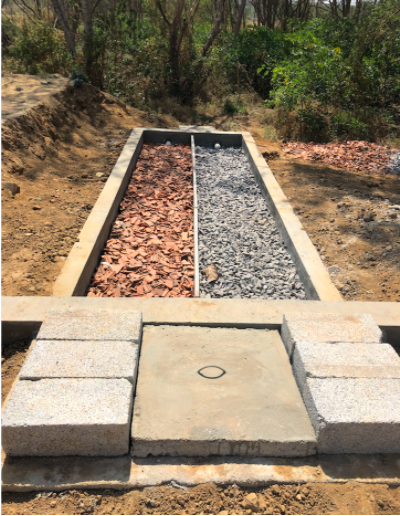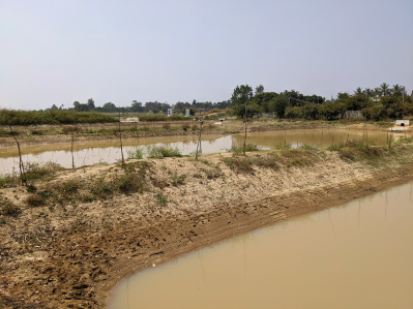A Visit to Vabasandra, Nanjapura, Kyalasanahalli lakes was done in February 2020 along with Mr. Anand Malligavad who has rejuvenated these lakes. All these lakes are located close to the Bommasandra Industrial area near Bangalore. The area adjacent to the lakes has agricultural fields, Layouts, Buildings and Factories. His aim is to rejuvenate 45 lakes in 12 streams by 2025.
Before rejuvenation the lakes were dry. Post rejuvenation all these lakes have water and the groundwater level has increased in the surrounding areas. The villagers adjacent to the lakes mentioned that Borewells and wells around the lakes have more water post rejuvenation
All Lakes have been funded for rejuvenation by different companies.
Nanjapura, Vabasandra, Kyalasanahalli Lakes in Anekal Taluk
Nanjapura, Vabasandra, Kyalasanahalli Lakes
Nanjapura Lake: 18 acre lake was rejuvenated in 2020.
Nanjapura Lake PC: Anand Malligavad
Vabasandra Lake: A 9 acre lake was rejuvenated in 2019. Overflows into Kyalasanahalli Lake
Vabasandra Lake PC:Anand Malligavad
Kyalasanahalli Lake: A 36 acre lake, was rejuvenated in 2018.
Kyalasanahalli Lake. PC: Anand Malligavad
Some observations on the design and features of the rejuvenated lakes
Details of desilting works that is carried out :
Desilting is carried out with help from local contractors. No desilting is carried out for upto a distance of 50m from the bund. This is to ensure that no cracks or destabilisation of the bund happens as a result of the desilting work. Increase in depth of the lake bottom is gradual from the perimeter to the central parts of the lake. Shallow Depths have been maintained near the perimeter of the lake to ensure safety of people who may walk in. Deep and shallow points also exist within the lake.
Hadosiddapura Lake after desilting and bund work PC: Anand Malligavad
Bund:
A ring bund is created around the lake. At Nanjapura lake the slope of the bund is 1:4 at the outlet side. The bund is not a single sloped surface but is made up of 3 terraces/steps. Napier grass has been planted in the lowermost step. This was recommended by Tamilnadu University. Cattle herders come to collect this grass for their cows. It is said that cows prefer this grass. Plants and trees such as Arjuna which can thrive even under submerged conditions have been planted on the middle step. Ficus and fruit trees are planted on the uppermost step. The thought is that these trees will provide shade and fruit to the birds and the community.
Stone pitching has been kept to the minimum - so as to avoid import of materials from outside the lake..
In Nanjapura and Vabasandra the bund at the outlet side has the walking path which is 10ft wide. Walking path on the main bund has not been paved with paver blocks or any external material. Mud and gravel are used to create this walking path. Walking path is created on only one side of the lake. Rest of the area is accessible only for maintenance with a very narrow path. This area also acts as conservation/biodiversity space.
The bund is raised above road level. To walk from the road level to the bund, steps are provided. This is to ensure that vehicles do not ride on the bund and also prevents encroachment and garbage dumping.
Steps from the road leading to the bund and Walkway on the bund at Nanjapura lake
Inlets and Outlets
All drains leading to the lake and out of the lake have been cleaned.
Instead of creating concrete silt traps, a deep pit has been created which serves as a silt trap at the inlets. Here the silt settles down and water overflows into the lake. Trees and shrubs have been planted around it which prevent accidents and dumping of garbage into the pit.
This pit is emptied as and when required by Mr Anand along with the help from local neighbours of the lake
Deep pit silt trap at Kyalasanahalli
Drain carrying wastewater into the lake and Clear water after passing through the wetland at Vabasandra lake
Wetlands
At all major inlets a series of 3 to 4 settlement tanks have been built. Each tank is separated by a mud wall/bund This is treated as a wetland. Water passes through each tank and gets purified before it enters the next tank. There are openings provided in the center of the separation wall for water to flow from one tank to the next. A path has been left for JCB to enter the wetland for maintenance. Some of the tanks/wetlands also act as Kalyani for idol immersion and other religious purposes.
Series of Wetland / Settlement tank at the inlet - Nanjapura Lake
In case of Vabasandra Lake it was observed that the wastewater drain from the village joins the lake after passing through the wetland. Wetland has alligator weed and knotweed which are growing naturally. No wetland species have been introduced. The water gets filtered here before it enters the lake.
It was observed that the water entering the lake is of better quality. Many fish and some submerged macrophytes were found growing in the lake.


Submerged macrophyte at Vabasandra lake A Snake cooling itself in Vabasandra lake
Islands
Islands have been created in the lake using the mud from the lake. Ficus, fruit and other trees have been planted on the island.
Water Levels
Old concrete electricity poles with markings have been used as markers in the lakes. They have been placed at multiple places in the lake. These markers help calculate the volume of water in the lake at any given time. They also act as a safety feature so that people can be aware of the depth of water at a particular point and hence be careful when they go into the deeper area.
Monitoring the changes in water level by observing the the marks made by water on the bund helps in understanding seasonal variations in water levels
Water Level markers in the lake
Lines observed on the bund due to evaporation
Devara Kadu - Miyawaki Forest
In some of the lakes two types of forest have been created. One is the Miyawaki forest where the planting is very close. The other where the trees have been planted 10ft apart.
At Lakes which have space, Miyawaki forests have been created. This is fenced using barbed wire and bougainvillea. Bougainvillea has been planted as this will act as a natural fence and can sustain with minimum maintenance. No one is allowed to enter the Miyawaki forest.
Miyawaki Forest at Vabasandra lake
Fishing
Before rejuvenation of the lake an agreement is made with the Panchayat that the lake should not be given for commercial fishing. No net should be used for fishing at the lake. Individuals can fish any amount at the lake using a rod. This helps the villagers to continue to use the lake for fishing.
Fence
There is no fence around the lake. However, where required bougainvillea is planted which creates a natural fence.
Space for washing clothes
In some lakes where people use lake water to wash clothes, a space has been created with gradual slope for washing.
Women washing clothes at Kyalasanahalli Lake
Swimming at the Lake and Sign Boards
Swimming is allowed in the lakes. Sign boards are placed around the lake with ‘Danger do not swim here’ in case there is danger in the area such as boulders etc.
Sign Board - Danger do not swim here
Benches
Benches are provided on the pathway on the bund.
Benches on the walking path
Preserving old carved stone found at the lake
Old stone with the carving of a snake was found at Nanjapura lake. It has been installed at the lake bund. A platform has been created for people to worship it.
Preserving old inscription stone - Nanjapura lake
Lake maintenance :
A gardener is appointed to take care of the plants/trees in the lakes.
Anand Malligavad has a very close connection with the villagers at all the lakes he has been involved with.
Lake groups have been created at each lake. This group alerts/stops any unacceptable activities that are carried out in the lake area - like felling of trees, drinking, driving on the bund, cattle grazing on planted trees etc. With the help of the Lake Group / local community the activity is stopped immediately.
Cleaning the lake is done with volunteers from the village when required.
Contact Information
Anand Malligavad : m.anand161980@gmail.com





























